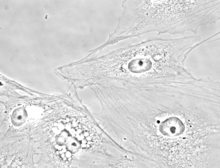Ptk2 cells
PtK2 Cells are a cell line derived from male rat-kangaroo (Potorous tridactylis) epithelial kidney cells.[1] This cell line is used for a variety of application in biomedical research but is particularly popular as a model for mitosis.[2]

Origin
The PtK2 cell line was established by Kristen Walen and Spencer Brown in 1962.[3] Cells from the rat kangaroo were selected as the source of a cell line because this species has only a small number of chromosomes and these chromosomes are easily visualized under a microscope. This makes these cells particularly suited to studying mitosis.
Characteristics
PtK2 cells are relatively large and when grown in a monolayer stay flat throughout the cell cycle unlike many cells that round up during mitosis.[4] PtK2 cells are resistant to adenovirus 5, coxsackievirus B5, and poliovirus 2. They are susceptible to coxsackievirus A9, herpes simplex, vaccinia, and vesicular stomatitis (Ogden strain).[5] PtK2 cells contain intermediate filaments composed of Keratin.[6]
References
- ↑ "PtK2 (NBL-5) (ATCC® CCL-56™)". Retrieved 17 December 2013.
- ↑ Elgin, edited by Barbara A. Hamkalo, Sarah C.R. (1991). Functional organization of the nucleus a laboratory guide. San Diego: Academic Press. p. 143. ISBN 008085933X.
- ↑ Walen, KH; Brown, SW (Apr 28, 1962). "Chromosomes in a marsupial (Potorous tridactylis) tissue culture.". Nature. 194: 406. doi:10.1038/194406a0. PMID 14004541.
- ↑ "Molecular Expressions Microscopy Primer: Specialized Microscopy Techniques - Fluorescence Digital Image Gallery - Male Rat Kangaroo Kidney Epithelial Cells (PtK2)". Retrieved 17 December 2013.
- ↑ Steubing, Rosemarie; Lindl, Toni. Atlas of Living Cell Cultures. Weinheim: Wiley. p. 465. ISBN 3527669930.
- ↑ "Olympus Microscopy Resource Center | Fluorescence Digital Image Gallery - Epithelial Cells". Retrieved 17 December 2013.